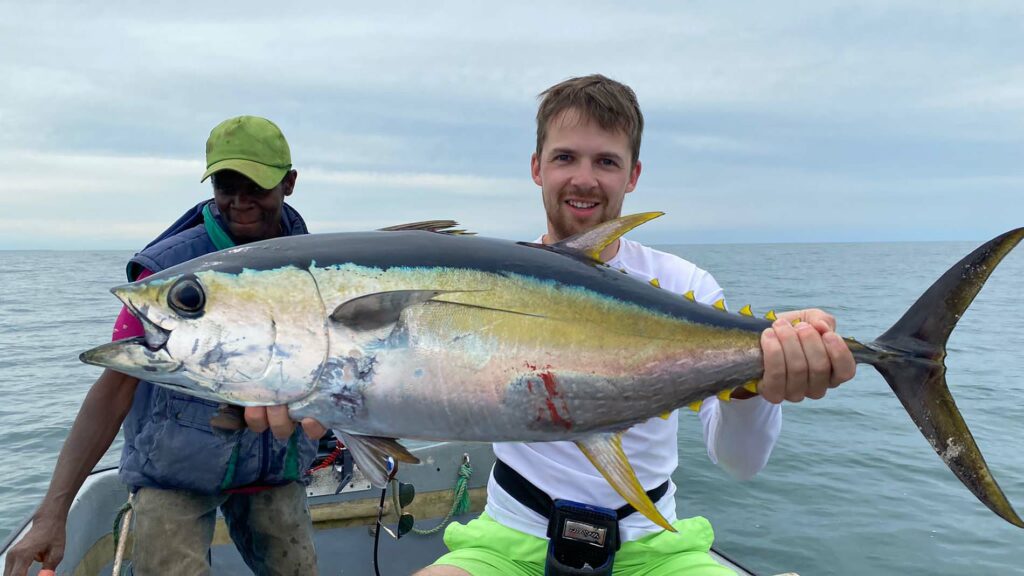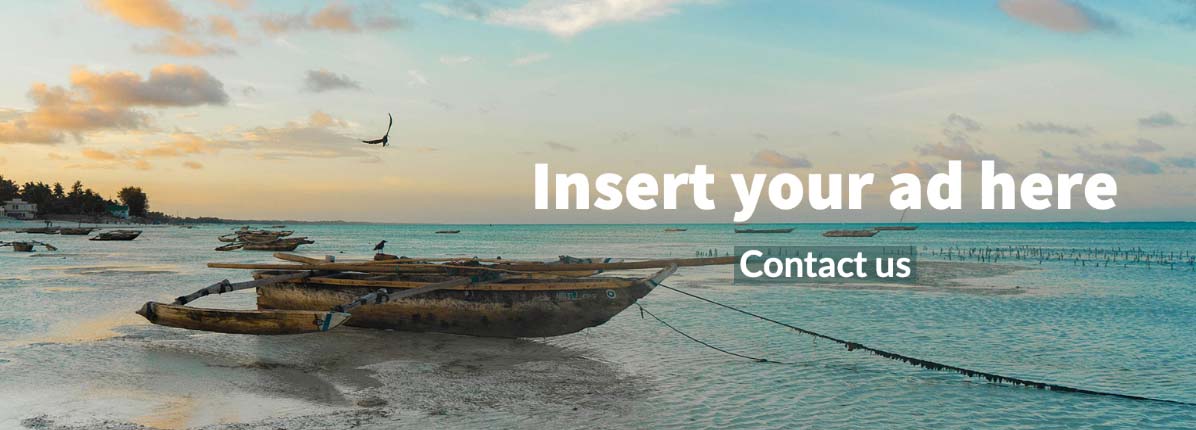The boat comes to a stop with a sudden jerk. Something’s biting! We are sailing at about thirty kilometers per hour, but the fish pulls the boat to a stop without any difficulty at all. It must be a big one! Nathan, the guide from the Blue Reef Sports & Fishing Lodge, tries to reel it in. Unfortunately, it gets away…
Catching some fresh tuna for dinner is today’s goal on this big game fishing trip. The chef of the lodge serves up the most delicious dishes, made from your own catch. We left Kizimkazi, Zanzibar this afternoon around 1:00 PM with two boats, and headed out to the Indian Ocean. On the way, we come across a traditional fishing boat. The boat is carved from a piece of mango tree and is steered by a large sail. The fisherman proudly shows off a 1.5 meter wahoo, a large species of fish that lives in tropical waters. That bodes well!
Record: 90 kilos tuna
At the bar of Blue Reef Fishing Lodge, the records are listed. The biggest fish caught here is a huge 90kg yellowfin tuna. “Three men spent more than an hour and a half just reeling it in. They were completely exhausted after that,” says Nathan.

The yellowfin tuna population here is still in good shape, according to Nathan. Fortunately, commercial companies do not fish on a large scale here. “Only the local population takes to the water here, and they only take one hundred to two hundred kilos of fish out of the water by boat. Compared to commercial shipping, that is nothing.”
The underwater life in the sea near Zanzibar is therefore rich and is full of big tuna. Fifteen, twenty kilos per yellowfin is no exception. “This type of fish doubles in weight every year,” our guide explains. To grow like this, they have to hunt a lot, and with gusto, a real spectacle to see, according to Nathan. Sounds very interesting! In turn, the tuna is hunted by bull sharks. “While fishing, you can also regularly see them hunting between the schools of tuna.”
Big game fishing trip
The sea conditions are perfect today. It is very hot out, and sailing gives us a pleasant breeze. There is also no wind, so we can sail quietly without any high waves. We soon spot a lone gannet in the sky. Floating in the clear blue sky, the bird is looking for the tuna, just like us. “Birds’ eyes have special lenses that allow them to look deep into the water and easily spot schools of fish”, Nathan explains. The bird dives into the water at great speed and sees an opportunity to catch a fish. We also decide to make a first attempt at big game fishing and cast our first rod out into the Indian Ocean.
Soon the bird has disappeared from our sight, and we continue to search for a large flock of birds. “The animals betray from the air the exact location where the yellowfin tuna are hunting.” In the distance we see a flock of at least fifty birds circling. “That way!” Our guide calls out to the captain: “When there are many birds circling above a spot, you know that deep below the surface of the sea there is a lot of hunting going on. Schools of tuna fanatically chase small bait in groups of up to a hundred. The tuna pushes the bait to the surface, where the birds get their share.”
Gannets
We sail toward the group of gannets, full throttle. With the skyline of Dar es Salam in the distance, we see dozens of birds diving into the water. We found the tuna! Nathan can see from the somewhat smaller splashes that we are dealing with Bonita (a small tuna species). We cast a few times, but the fish quickly leave.
We sail on among at least five large flocks of birds waiting in the water for their dinner. “Something’s about to happen here somewhere, no question about it, and birds know it.” Suddenly the first group of seabirds flies off at breakneck speed, seeming to know exactly where to go.
And indeed, the winged scouts are leading us to the right place. They dive into the water en masse, and we see splashes all around us. But this time the water is splashing much more because yellowfin tuna of about 50 centimeters are jumping out of the water, with spectacular splashes: a magical spectacle. Game time! We sail around the school with the boat, so that they swim in our direction. We cast a rod with a plopper into the middle of the school of fish. By jerking the line, you create splashes in the water that attract the attention of the tuna. After a few throws they’d already left. They’re fast! They hunt at a speed of eighty kilometers per hour, so it’s not surprising that they’re gone within a fraction of a few seconds.
Dolphins
After a number of failed attempts like this, the boat ends up in a perfect position, almost right in the middle of the hunting grounds! We see about a hundred tuna jumping out of the water nearby. “Look! A mahi-mahi is also hunting.” We see the green-blue scales glittering in the water. Soon Nathan has a hold of the plopper and pulls a wahoo with razor sharp teeth out of the water. The fish is over a meter long and weighs 7.5 kilos. Not a record, but for a first-time fishing experience in the tropics I was pretty impressed.
When we sail back, we meet the other group from the resort. They also caught something: a five-kilo yellowfin tuna. And they got an extra bonus: along the way they were accompanied by a group of dolphins. What an incredibly beautiful experience it is to float around the sea here for a few hours!
Join a big game fishing trip with Blue Reef Sport & Fishing Lodge. Cost: $220,- for 5 hour, $300,- for an 8 hour trip . Check out the website of Blue Reef Fishing Lodge for more information.


Recent Comments